Phil Coffman on Method & Craft
Art director Phil Coffman recently launched Method & Craft, a site devoted to sharing insight into how designers create their work. Oliver Lindberg caught up with him in his hometown Austin to hear all about the project
.net: How did Method & Craft come about?
Phil Coffman: The idea came to me in April last year. I realised I had learned a lot of things over the last 10 years I’ve been doing design and felt I could record some videos to give back to the community. So I sent out a tweet and got a lot of positive feedback. Then I thought the project should have its own site, maybe create it on Tumblr, but it kept growing from there.
Ultimately it became a site that I would not only build and contribute to, but also a place where I could hear from my peers who use the exact same tools that I use. I’m a big movie fan, so much so that I watch the DVD extras with as much interest as I do the film because I love to see creative people talk about how they get to their end result. It’s inspiring to see the creativity not only in what they produce but also in their process.
.net: How did Noah Stokes’ get involved?
PC: I meet Noah at last year’s SXSW for the first time in person. We'd been following each other on Twitter for a while and he had a project called FRVNT that he needed some design help with, so I collaborated with him on that. It was around this same time that the idea for Method & Craft came to me, so I emailed him telling him about it simply to see what he thought about it. He loved the idea and even offered to build it for me. Noah is a very talented developer, front-end and back-end, and working with him has taught me a lot about his area of expertise as well as web design in general. We've also become good friends through these experiences.
.net: Noah is in a different time zone. How did that work?
PC: He’s two hours behind, so we have some overlap during the day when we’re both working and can chat via IM or talk on Skype. The challenges came in the evening. We both have families, so working after hours required careful scheduling in order to make sure we weren't neglecting our wives and kids. I would get online at about 10 o'clock here in Austin, which was right about when Noah was finishing up putting his kids to bed. We'd work for about two hours and then I'd be done for the night. Since he still had a couple hours of working time left in the day, I made to-do lists on Basecamp and shot him a few emails before I went to bed. The time difference wasn't too bad, but it did slow things up a little.

.net: What’s Trent Walton’s involvement?
PC: Trent and I also met in person at SXSW last year. We both live in the Austin area. I respect Trent’s work and as I got to know him better I learned how smart he is. In the span of a year he’s built a name for himself and has become very well-connected. It started as a friendship, again, but as much as I bounced ideas of Noah, I bounced them off Trent because I wanted another designer to take a look at what I was doing, validate it and give me good, honest feedback. I also asked him to give me some ideas on some things that we could do in terms of CSS and front-end experimentation. His job now is to help promote the site and assist with our interviews.
.net: What technologies did you use?
PC: We’re using Typekit to serve up web fonts and a technology called Backstretch for the background photo. Scott Robbin at Weightshift developed it and it takes a background photo and proportionally scales it depending on the size of your browser. Method & Craft is running on ExpressionEngine and we use the SublimeVideo player powering our video tutorials. Sublime is built in HTML5 so it works on iPad and iPhone perfectly, but offers a Flash fallback. The guys behind Sublime contacted us and gave us a couple of performance tips, which we implemented to make the videos perform better. Method & Craft is for the design community and we know that a lot of people in that community have fast machines and the latest browsers, so we played into that where we could.
.net: How do you want to develop it further?
PC: I’m focused right now on making sure the content schedule stays on track. We're discussing ideas such as video interviews and premium content, plus ways we can take the brand and extend it beyond the website.

.net: How’s the hunt for contributors going?
PC: I’ve got a lot of people who are interested. Some big names and some people who aren’t as well-known which is important because I want the spread of authors to be even across disciplines and experience. There are so many people who are brilliant but haven't had the opportunity to be as publicised. We hope to give these people a chance to get their name out and share their work.
.net: You dabble in quite a few side projects. What does the company you work for, Springbox, think about it?
PC: Thankfully the company as a whole is pretty accepting of freelance work as long as you’re getting your work done and not wearing yourself out. My boss and I have a great relationship. He’s very open to what I do and he’s seen that the more I’m involved with the side projects it just makes me a better employee. I'm able to work on my side projects whenever I have downtime at work, obviously as long as I'm performing well and meeting my deadlines. I like to share the knowledge I learn from doing side projects to the company and my co-workers. Recently I discussed a little about what's powering Method & Craft to my co-workers since we don't always have the opportunity to use the latest technologies with our clients.
.net: Any tips for people who want to start their own side projects?
PC: If you are working for an agency, you need to talk to your employer. You need to talk about whether or not they’re going to be okay with you taking something like this on because it will take up a lot of your time. You also want to make sure that they don’t have a clause that they have ownership, if you’re working on something. You want to get all of that ironed out. I encourage everyone work on a side project because it gives you the chance to play with new technologies and maybe do something that you don’t get to do with client work. Also it gives you a chance to be in control. If you’re an entry level designer, this gives you the chance to really own something, see it through from start to finish and see how well you do with having to be responsible for the project. And if you bring in other people, how well do you manage them and how well can you delegate? There are a lot of leadership opportunities. If you’re self-employed you can directly apply this to your business. If you work for an agency, you’ll become more well-rounded which makes you a more valuable employee. I think a lot of companies are looking for someone who is not just technically savvy but someone who knows how to manage their time and how to balance and delegate.

Thank you for reading 5 articles this month* Join now for unlimited access
Enjoy your first month for just £1 / $1 / €1
*Read 5 free articles per month without a subscription

Join now for unlimited access
Try first month for just £1 / $1 / €1
Get the Creative Bloq Newsletter
Daily design news, reviews, how-tos and more, as picked by the editors.

The Creative Bloq team is made up of a group of art and design enthusiasts, and has changed and evolved since Creative Bloq began back in 2012. The current website team consists of eight full-time members of staff: Editor Georgia Coggan, Deputy Editor Rosie Hilder, Ecommerce Editor Beren Neale, Senior News Editor Daniel Piper, Editor, Digital Art and 3D Ian Dean, Tech Reviews Editor Erlingur Einarsson, Ecommerce Writer Beth Nicholls and Staff Writer Natalie Fear, as well as a roster of freelancers from around the world. The ImagineFX magazine team also pitch in, ensuring that content from leading digital art publication ImagineFX is represented on Creative Bloq.
